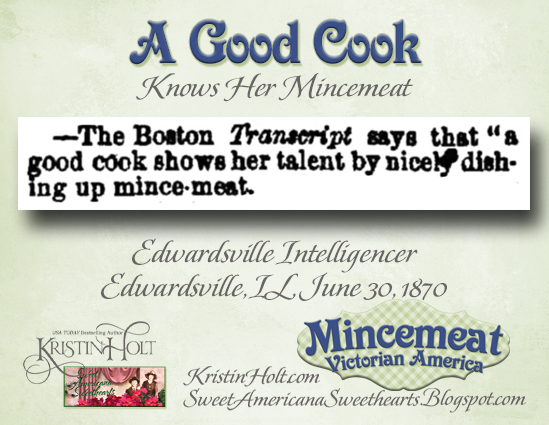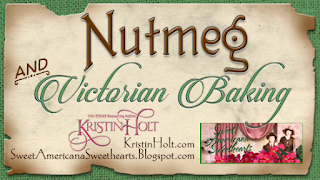by Kristin Holt, USA Today Bestselling Author of
Sweet Romance set in the American Old West
This post contains affiliate links.
Mincemeat
Mincemeat pie, as known today, would be barely recognizable by King Henry V (died 1482). This English king served the meaty fermented pies at his 1413 coronation feast. A variety of meats (venison, fowl, mutton, together with their sweetbreads) were minced (chopped finely)--hence the name mince pie or minced meat pie. Other ingredients included fruits (dates, raisins), vinegar and/or wine, and suet.
Nineteenth century recipe books and newspapers offer many examples of Victorian-era mincemeat pies--and many other minced meat dishes. Peering into kitchens of yore through their recipes sheds so much light on how our great-great grandmothers lived! Some of their methods may surprise you (I still wonder how their methods diminished food-borne illness.) After all, mincemeat apparently took all day to make and required at least 24 hours to sit before sending to table. Cooks made batches so enormous they would keep all winter by virtue of their alcohol content, cool temperatures, and the magic of fermentation.
 |
| Edwardsville Intelligencer of Edwardsville, IL, June 1870. |
Through the centuries, mince pies became a Christmastime staple in English-speaking countries and were banished in an attempt to thwart paganism in Christmas celebrations. Outlawed foods and parties couldn't be silenced. By the 19th century, mince was back, fully entrenched in the hearts of Englishmen. Americans embraced the tradition of mincemeat pies no matter where they began.
I'm not sure how I'd feel, had I read this article back in 1872. The manager's comment leaves me uneasy: "Age don't hurt our mince-pies--they are good a year old."
Just as cheese is milk's leap into immortality, so is a mincemeat's edibility ensured for months to come.
Victorian Mincemeat Ingredients
By the time Victoria reigned, mincemeat pies had at least 500 years to slowly morph. The traditional rich filling now included spices like cinnamon, nutmeg, cloves, mace, allspice and rose water. Wine had given way to brandy and cider. Temperance recipes expressly called for cider instead of liquor. Fruits minced into the filling included apples, raisins, currants, citron, lemons, and oranges. Some ingredients, like suet, remained a significant inclusion. Now, instead of mostly meats, recipes called for one-third to one-half meat to two-thirds or one-half fruit. With the increase in fruit-to-meat ratio and the addition of refined sugars, mincemeat had become far more of a dessert dish than a main course. But don't forget the mincemeat pies in nineteenth-century America still contained meat. Far more than today's commercial mincemeat's nod toward beef.
Vintage Mincemeat Recipes
Imagine how long it took great-great grandma to whip up a batch of mince pies? Reading these instructions, I see hours of labor. Notice the last line of paragraph one: "This will fill twenty pies." Not all at once, of course. This filling would be stored in a cool place, packed into stone jars. Some vintage recipes instruct cooks to cover the mincemeat surface with paper soaked in brandy, or to simply tie down fabric coverings. Others employed jar lids.
 |
| Mince Pies recipe from 1851 publication: The American Matron on Practical and Scientific Cooking by a Housekeeper |
Many 19th century mincemeat recipes start with a fresh beef tongue or two. Others start with a beef heart. Many recipes (a.k.a. receipts) suggest any lean beef will do. After boiling to fully cook and tenderize, the meat is minced fine along with all sorts of good things.
This American Civil War-Era recipe (1864) for Mincemeat (and storage of prepared mince) appeared Poetical Cook Book by Maria J. Moss. Note the recipe calls for a beef heart or fresh tongue.
 |
| Mincemeat in Poetical Cook Book by Maria J. Moss, 1864. |
Mincemeat Sold Commercially, Victorian U.S.A.
With the quantity of hours required to make homemade mincemeat, no wonder many cooks turned to commercially available products. Vintage newspapers throughout the American Victorian-era show how readily available mincemeat was at markets in cities and rural frontiers alike.
It's curious, at a time when contamination and adulteration of food was unregulated, well-known, feared, and sickened (and killed) people, that Americans would embrace a product like factory-made mincemeat.
Victorian Factories Crank Out Mincemeat
None Such (a brand still around today) advertised in 1896 the labor-saving ease of their "very finest, purest and cleanest materials."
 |
| None Such Mince Meat, Factory Made. Advertised in Record-Journal of Meriden, CT, May 1896. |
Mail Order Mincemeat
The 1897 catalogue from Sears, Roebuck & Co. (No. 104) sold both Challenge Brand Mince Meat (wet) put up in quarter barrels or pails of various sizes (including glass pails) and a dry mince meat preparation by Richelleu.
 |
| Two brands of mince meat sold in the 1897 Sears, Roebuck & Co. Catalogue (No 104). |
Invitation
Do you have fond memories of Grandma's Mincemeat Pie?
Have you baked a mincemeat pie?
Comments are welcome! Please scroll down and contribute.
Related Articles
Copyright Ⓒ 2021 Kristin Holt LC














Interesting post. No I dont like this pie. When there were only four of us five kids, grandma "D" (dads mom) made mincemeat pie one thanksgiving. I dont know what was in it, but it was horrible. Thank goodness for the dog under the table. She got a lot of pie from us four kids. Poor thing go sick. We didnt want to hurt grandmas feelings. We all loved her to distraction. Thankfully she never made this pie again. She did make a strawberry rubarb pie that was wonderful. And she made it every year after that for thanksgiving.
ReplyDeleteI bought a quart jar of mincemeat last spring leftover from the holiday season and on a clearance shelf for $.99!! I ate it straight out of the jar a spoonful at a time - one thing hubs won't touch!! LOL!
ReplyDelete